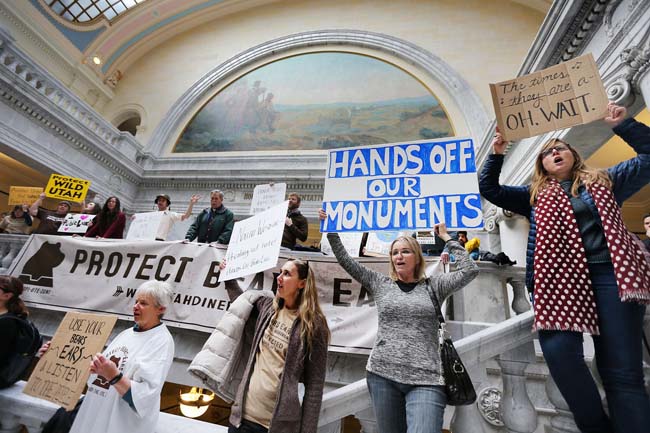The danger of local hands on public lands. When it comes to monuments, Utah lawmakers have conflicts of interest
by Jonathan Thompson / High Country News / March 2, 2018
NOTE: Republished with permission.
[dropcap]W[/dropcap]hile the fight over President Donald Trump’s shrinking of Bears Ears National Monument has mostly migrated to the courts, another Bears Ears battle continues to rage. This one is over a congressional bill sponsored by Rep. John Curtis, a Utah Republican.
At first glance, H.R. 4532 seems to give monument proponents everything they asked for and then some. While it would lock in Trump’s shrinkage, it would also put all of the 1.35 million acres in the original monument off-limits to future mining claims and drilling leases, just as a monument would have done. Not only would the original Bears Ears Commission, an advisory group made up of tribal representatives, remain intact, but it would be joined by a “tribal management council” that would oversee the Shash Jáa (Navajo for Bears Ears) unit of the monument.
So why are the tribal leaders who fought for the monument asking Curtis to withdraw his bill? For starters, the bill codifies and perpetuates Trump’s nose-thumbing at those tribes, since the bill was devised without consulting tribal leaders. Meanwhile the so-called tribal management council is merely a sneaky way to put control of public lands into the hands of a small group of locals, a situation that can jeopardize the public good and the health of the land.
The tribal council would be made up of just one federal land management official, who would be mixed in with two local county commissioners, three members of the Navajo Nation and one member of the Ute Mountain Ute Tribe. Significantly, the Navajo and Ute councilors would not be official representatives of the respective tribal nations, but individual citizens, appointed by the president in consultation with the Utah congressional delegation (again, with no input from the tribal nations themselves).

Trump’s order to remove protections for national monuments has conservative hunters, fishers and sporting groups slowly coalescing and they may determine the fate of national monuments. Image Scott G Winterton, Deseret News.
This new national monument, then, would be run by a committee of local individuals
On one level, this makes sense. When it comes to making decisions on public lands, the residents of the rural communities adjacent to the land have an inherent advantage over bureaucrats who take their orders from Washington. Locals tend to know the land in which they live, hike and work on a regular basis more those who reside far away. A live-in landlord will always be a more responsive steward than an absentee one.
Yet the live-in landlord — or the local land manager — is also far more likely to have a personal, financial interest in what happens on that land. These sorts of conflicts of interest are an unavoidable part of life in small, rural communities.
Take, for example, Utah State Rep. Mike Noel. When Interior Secretary Ryan Zinke “reviewed” national monuments last year, he turned to Noel for advice. Noel is a longtime Sagebrush Rebel from southern Utah and an outspoken opponent of national monuments in his home state. Noel not only had an ideological interest in the outcome of the review, but a handful of personal and financial interests as well.
Rep. Mike Noel greets guests arriving at the Utah Capitol in December 2017, where President Donald Trump signed a presidential proclamation to shrink Bears Ears and Grand Staircase-Escalante national monuments.
In February, the Western Values Project, a conservation group, published documents that showed that Noel owns property within the Grand Staircase-Escalante National Monument, which he failed to disclose in his conflict-of-interest filings for the Utah Legislature. When Trump redrew the boundaries of the monument, it was done so that Noel’s parcel fell just outside the monument boundaries. As such, it has all the desirability of being adjacent to protected federal land, without the difficulties of access that can plague private inholdings.
There’s more: As executive director of the Kane County Water Conservation District, Noel has long been a booster for the proposed Lake Powell Pipeline, which would benefit the water district and deliver much-needed water to portions of the 500 acres Noel owns in the county. The pipeline’s proposed route ran through the original monument, obliging it to extra regulatory hurdles. Now it doesn’t, thanks to Trump’s monument shrinkage, which brings the pipeline one step closer to fruition.
Given how small the local population is around Bears Ears, Curtis’ Shash Jáa management council is almost certain to be plagued by similar conflicts of interest. A council member might own property next to, or grazing allotments within, the monument; she may work as an adventure guide who takes clients into the monument, or have an ATV rental shop that would be affected by monument trail restrictions. Would they really make decisions in the best interest of the land if it might hurt their own bottom line or even put them out of business? Being local does not a steward make.
That’s not to say local voices should be dismissed. But when it comes to public land, locals should have the same say that all other Americans do. We Westerners may scoff at bureaucrats, but they have one thing going for them: It’s their job to make decisions based on the greater public good. And in the end, public lands are for the American public, not for the communities that happen to lie closest to them.
About Jonathan Thompson
Thompson is a contributing editor at High Country News. He is the author of River of Lost Souls: The Science, Politics and Greed Behind the Gold King Mine Disaster.

